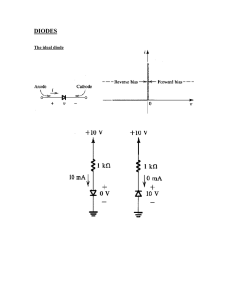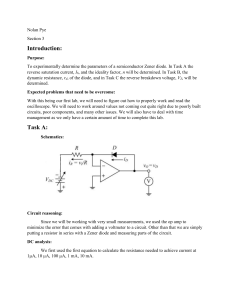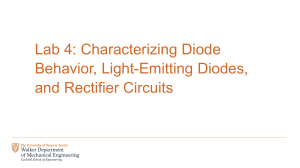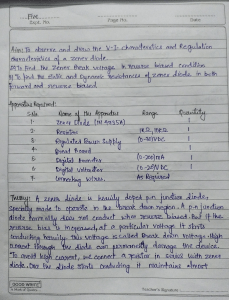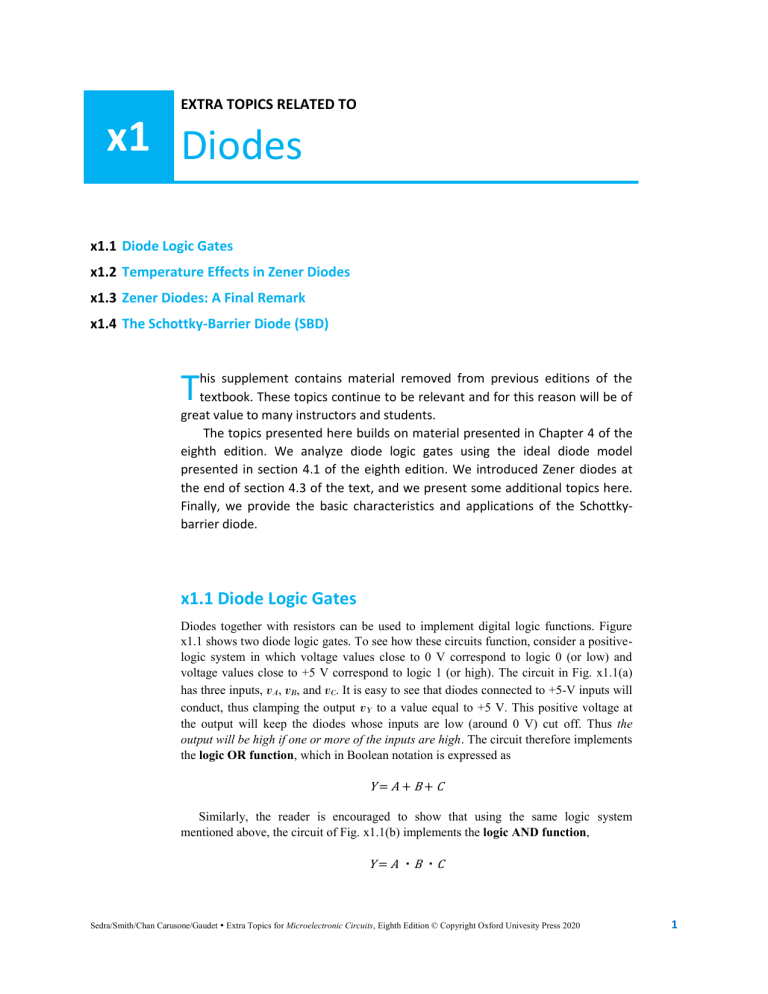
EXTRA TOPICS RELATED TO x1 Diodes x1.1 Diode Logic Gates x1.2 Temperature Effects in Zener Diodes x1.3 Zener Diodes: A Final Remark x1.4 The Schottky-Barrier Diode (SBD) T his supplement contains material removed from previous editions of the textbook. These topics continue to be relevant and for this reason will be of great value to many instructors and students. The topics presented here builds on material presented in Chapter 4 of the eighth edition. We analyze diode logic gates using the ideal diode model presented in section 4.1 of the eighth edition. We introduced Zener diodes at the end of section 4.3 of the text, and we present some additional topics here. Finally, we provide the basic characteristics and applications of the Schottkybarrier diode. x1.1 Diode Logic Gates Diodes together with resistors can be used to implement digital logic functions. Figure x1.1 shows two diode logic gates. To see how these circuits function, consider a positivelogic system in which voltage values close to 0 V correspond to logic 0 (or low) and voltage values close to +5 V correspond to logic 1 (or high). The circuit in Fig. x1.1(a) has three inputs, vA, vB, and vC. It is easy to see that diodes connected to +5-V inputs will conduct, thus clamping the output vY to a value equal to +5 V. This positive voltage at the output will keep the diodes whose inputs are low (around 0 V) cut off. Thus the output will be high if one or more of the inputs are high. The circuit therefore implements the logic OR function, which in Boolean notation is expressed as Y=A+B+C Similarly, the reader is encouraged to show that using the same logic system mentioned above, the circuit of Fig. x1.1(b) implements the logic AND function, Y = A ・B ・C Sedra/Smith/Chan Carusone/Gaudet Extra Topics for Microelectronic Circuits, Eighth Edition © Copyright Oxford Univesity Press 2020 1 Figure x1.1 Diode logic gates: (a) OR gate; (b) AND gate (in a positive-logic system). Example x1.1 Assuming the diodes to be ideal, find the values of I and V in the circuits of Fig. x1.2. Figure x1.2 Circuits for Example x1.1. Solution In these circuits it might not be obvious at first sight whether none, one, or both diodes are conducting. In such a case, we make a plausible assumption, proceed with the analysis, and then check whether we end up with a consistent solution. For the circuit in Fig. x1.2(a), we shall assume that both diodes are conducting. It follows that VB = 0 and V = 0. The current through D2 can now be determined from 𝐼𝐷2 = 10 − 0 = 1 mA 10 Writing a node equation at B, Sedra/Smith/Chan Carusone/Gaudet Extra Topics for Microelectronic Circuits, Eighth Edition © Copyright Oxford Univesity Press 2020 2 𝐼+1= 0 − (−10) 5 results in I = 1 mA. Thus D1 is conducting as originally assumed, and the final result is I = 1 mA and V = 0 V. For the circuit in Fig. x1.2(b), if we assume that both diodes are conducting, then VB = 0 and V = 0. The current in D2 is obtained from 𝐼𝐷2 = 10 − 0 = 2 mA 5 The node equation at B is 𝐼+2= 0 − (−10) 10 which yields I = −1 mA. Since this is not possible, our original assumption is not correct. We start again, assuming that D1 is off and D2 is on. The current ID2 is given by 𝐼𝐷2 = 10 − (−10) = 1.33 mA 15 and the voltage at node B is 𝑉𝐵 = −10 + 10 × 1.33 = +3.3 V Thus D1 is reverse biased as assumed, and the final result is I = 0 and V = 3.3 V. EXERCISES x1.1 Find the values of I and V in the circuits shown in Fig. x1.3. Figure x1.3 Sedra/Smith/Chan Carusone/Gaudet Extra Topics for Microelectronic Circuits, Eighth Edition © Copyright Oxford Univesity Press 2020 3 Figure x1.3 continued Ans. (a) 2 mA, 0 V; (b) 0 mA, 5 V; (c) 0 mA, 5 V; (d) 2 mA, 0 V; (e) 3 mA, +3 V; (f) 4 mA, +1 V x1.2 Figure x1.4 shows a circuit for an ac voltmeter. It uses a moving-coil meter that gives a fullscale reading when the average current flowing through it is 1 mA. The moving-coil meter has a 50-Ω resistance. Find the value of R that results in the meter indicating a full-scale reading when the input sine-wave voltage vI is 20 V peak-to-peak. (Hint: The average value of half-sine waves is Vp/π.) Figure x1.4 Ans. 3.133 kΩ x1.2 Temperature Effects in Zener Diodes The dependence of the zener voltage VZ on temperature is specified in terms of its temperature coefficient TC, or temco as it is commonly known, which is usually expressed in mV/C. The value of TC depends on the zener voltage, and for a given diode the TC varies with the operating current. Zener diodes whose VZ are lower than about 5 V exhibit a negative TC. On the other hand, zeners with higher voltages exhibit a positive TC. The TC of a zener diode with a VZ of about 5 V can be made zero by operating the diode at a specified current. Another commonly used technique for obtaining a reference voltage with low temperature coefficient is to connect a zener diode with a positive temperature coefficient of about 2 mV/C in series with a forward-conducting diode. Sedra/Smith/Chan Carusone/Gaudet Extra Topics for Microelectronic Circuits, Eighth Edition © Copyright Oxford Univesity Press 2020 4 Since the forward-conducting diode has a voltage drop of ≃0.7 V and a TC of about –2 mV/C, the series combination will provide a voltage of (VZ +0.7) with a TC of about zero. EXERCISES x1.3 A zener diode whose nominal voltage is 10 V at 10 mA has an incremental resistance of 50 Ω. What voltage do you expect if the diode current is halved? Doubled? What is the value of VZ0 in the zener model? Ans. 9.75 V; 10.5 V; 9.5 V x1.4 A zener diode exhibits a constant voltage of 5.6 V for currents greater than five times the knee current. IZK is specified to be 1 mA. The zener is to be used in the design of a shunt regulator fed from a 15-V supply. The load current varies over the range of 0 mA to 15 mA. Find a suitable value for the resistor R. What is the maximum power dissipation of the zener diode? Ans. 470 Ω; 112 mW x1.5 A shunt regulator utilizes a zener diode whose voltage is 5.1 V at a current of 50 mA and whose incremental resistance is 7 Ω. The diode is fed from a supply of 15-V nominal voltage through a 200- Ω resistor. What is the output voltage at no load? Find the line regulation and the load regulation. Ans. 5.1 V; 33.8 mV/V; –7 mV/mA x1.3 Zener Diodes: A Final Remark Though simple and useful, zener diodes have lost a great deal of their popularity in recent years. They have been virtually replaced in voltage-regulator design by specially designed integrated circuits (ICs) that perform the voltage-regulation function much more effectively and with greater flexibility than zener diodes. x1.4 The Schottky-Barrier Diode (SBD) The Schottky-barrier diode (SBD) is formed by bringing metal into contact with a moderately doped n-type semiconductor material. The resulting metal–semiconductor junction behaves like a diode, conducting current in one direction (from the metal anode to the semiconductor cathode) and acting as an open circuit in the other, and is known as the Schottky-barrier diode or simply the Schottky diode. In fact, the current–voltage characteristic of the SBD is remarkably similar to that of a pn-junction diode, with two important exceptions: 1. In the SBD, current is conducted by majority carriers (electrons). Thus the SBD does not exhibit the minority-carrier charge-storage effects found in forward- Sedra/Smith/Chan Carusone/Gaudet Extra Topics for Microelectronic Circuits, Eighth Edition © Copyright Oxford Univesity Press 2020 5 biased pn junctions. As a result, Schottky diodes can be switched from on to off, and vice versa, much faster than is possible with pn-junction diodes. 2. The forward voltage drop of a conducting SBD is lower than that of a pnjunction diode. For example, an SBD made of silicon exhibits a forward voltage drop of 0.3 V to 0.5 V, compared to the 0.6 V to 0.8 V found in silicon pnjunction diodes. SBDs can also be made of gallium arsenide (GaAs) and, in fact, play an important role in the design of GaAs circuits. Gallium-arsenide SBDs exhibit forward voltage drops of about 0.7 V. Apart from GaAs circuits, Schottky diodes find application in the design of a special form of bipolar-transistor logic circuits, known as Schottky-TTL, where TTL stands for transistor–transistor logic. Before leaving the subject of Schottky-barrier diodes, it is important to note that not every metal–semiconductor contact is a diode. In fact, metal is commonly deposited on the semiconductor surface in order to make terminals for the semiconductor devices and to connect different devices in an integrated-circuit chip. Such metal–semiconductor contacts are known as ohmic contacts to distinguish them from the rectifying contacts that result in SBDs. Ohmic contacts are usually made by depositing metal on very heavily doped (and thus low-resistivity) semiconductor regions. (Recall that SBDs use moderately doped material.) Sedra/Smith/Chan Carusone/Gaudet Extra Topics for Microelectronic Circuits, Eighth Edition © Copyright Oxford Univesity Press 2020 6
